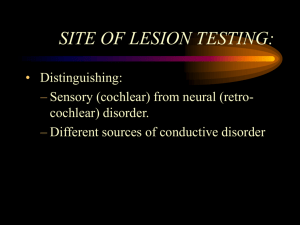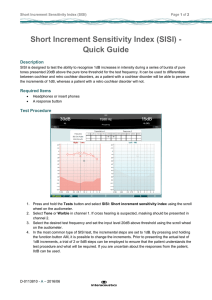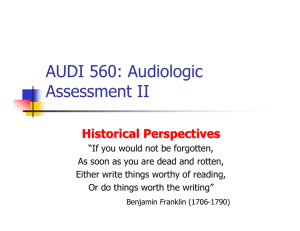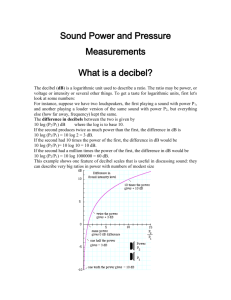Traditional audiological site of lesion test
advertisement
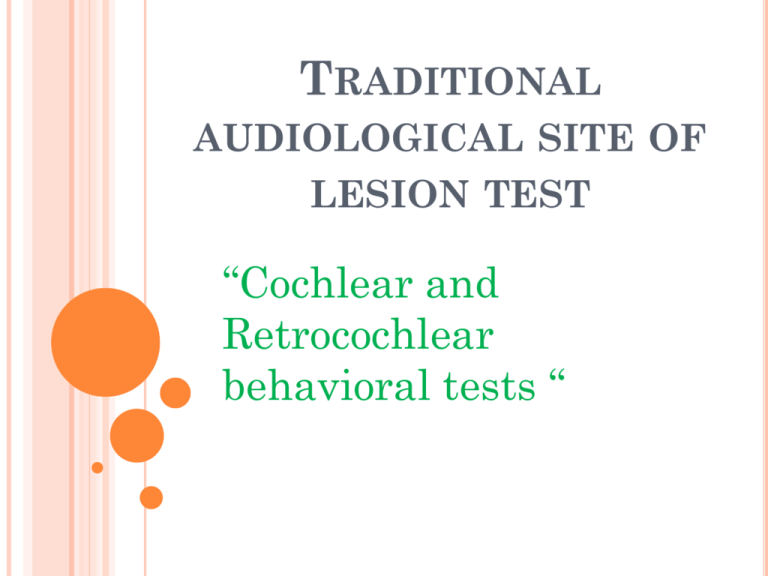
TRADITIONAL AUDIOLOGICAL SITE OF LESION TEST “Cochlear and Retrocochlear behavioral tests “ INTRODUCTION The audiologic test battery was developed to differentiate between cochlear and Retro-cochlear ( 8th nerve and extra-axial brain stem) etiologies It was used with unilateral or asymmetrical SNHL The traditional tests include: ABLB, SISI, tone decay, speech recognition, Bekesy, ART and reflex decay test Electro-nystagmo-graphy (ENG) and brain stem auditory-evoked potentials ( BEAPs) were added later LOUDNESS BALANCE PROCEDURES Recruitment: Abnormal growth of loudness for signals at supra-threshold intensity levels. Example: Person with 5 dB HL in one ear and 45 dB HL in the other ear, the tones are perceived equally like ( 5 is heard the same as the 45 dB HL in the other ear ) If the level increased to 70 dB HL in the better ear (65 dB SL) and this will be equal to 70 dB HL in the poorer ear ( 25 dB SL ), that means that 25 dB SL in the poorer ear was enough to make the sound equally like the 65 dB SL in the better ear The given example illustrating the most common loudness balance procedures ABLB and MLB ABLB compares loudness growth for the same frequency between different ears MLB compares loudness growth for the same ear at different frequencies ALTERNATIVE BINAURAL LOUDNESS BALANCE (ABLB) The examiner will present and control the stimuli The patient should judge about the loudness of the stimulus Good ear used as a (reference ear ) and the poorer ear used as (variable ear) For MLB, good frequency used as reference while, poorer frequency used as variable and the procedure is the same Test should be applied at different intensity levels Patient instructed that he will hear to tones, one constant in loudness and the other one variable The patient should states whether the variable one is softer than, louder than or equal to the reference ear. The signal in the reference ear should be presented at every sensation level for few seconds PLOTTING THE RESULTS AND INTERPRETATION The results plotted using what we call as ladder-gram Interpreted as Complete or partial recruitment ( cochlear pathology) No recruitment Decruitment ( Retro-cochlear pathology) However, attention should be paid as the previous research cited no recruitment in 15 to 27 % of patients with cochlear pathology Eighth nerve tumor is considered as retro-cochlear pathology. However, some patients with such tumors showed recruitment .. This possibly due to interference with cochlear blood supply and the size of the tumor Absence of recruitment or decruitment is seen in most patients with large tumors Loudness balancing procedures are effective in detecting CP but less so in ruling out RCP COMPLETE RECRUITMENT PARTIAL RECRUITMENT NO RECRUITMENT DERUITMENT MONAURAL LOUDNESS BALANCE (MLB) TEST It’s developed to assess recruitment in patient with bilateral hearing loss The test done for each ear separately between two frequencies (one normal hearing and one with hearing loss ) Procedure is the same as ABLB except that two tones of different frequencies will be presented for balancing One problem with MLB, that the balancing for different frequencies with the intensity are not necessarily perceived as equally loud Many patients find it difficult to do balance between tow tones heard in the same ear SHORT INCREMENT SENSITIVITY INDEX (SISI) SISI test was first developed by Jerger et al (1952,1953) It is a simple test where the patient should indicates when a steady tone increased in loudness Jerger has suggested that the SISI test should not be viewed as a test for recruitment rather it is a site of lesion test It’s results are complement to loudness balance testing. However, they are different tests CONVENTIONAL SISI TEST The test is administered by presenting carrier tone or steady tone at 20 dB SL ( based on the pure tone threshold) There will be increment in loudness about every 5 seconds The patient task is to indicates whenever s/he notice the increments 5- dB increments will be presented for several trails, typically heard by most patients Then, 20 of 1- dB increments will be played ( this is the real test ) Each correct response worth 5 % RESULTS Patients with cochlear hearing loss detect most of 1- dB increments (high or positive scores) Normal hearing people, patients with CHL or non-cochlear lesions got (low or negative SISI scores) Jerger has divided the scores as follow; 0-20 % >>> Negative or low SISI scores (normal hearers, CHL or RCP ( eight nerve lesions ) 25 – 65 % >>> questionable 70- 100 % >>> High or positive SISI scores ( cochlear loss) PROCEDURAL VARIATION IN SISI Several researches have been done it to shorten the test and improve its specificity and sensitivity To reduce false positive responses, some increments deleted To reduce false negative responses, increments of greater than 1 dB will be introduced As patients typically either hear most of increments or hearing just few or non of the increments, reduce the number of 1dB increments to 10 times rather than 20 is saving the clinical time 10 times increments suggested if for the first 10 ( 1 or non of the increments detected ( 0 to 10 %) or if 9 to 10 increments detected ( 90 to 100 %) Other than that, 20 times should be completed For 10 times increments, each correct response worth 10 % PRESENTATION LEVEL OF SISI AND D.D At the low presentation level (20 dB SL), Most normal hearers show negative or low SISI scores Many patients with mild to moderate cochlear loss at this usual level , show low or negative SISI scores (0-20 %) or questionable scores ( 25- 65 %) Those with greater cochlear loss show positive or high SISI scores (70-100 %) at this usual level However, with high presentation level (greater than 20 dB SL), All of normal hearers and those with mild to moderate or greater cochlear loss showing high or positive scores … Always patients with RCP showing low or negative SISI scores ( below 25 %) at usual level (20 dB SL) Some researchers suggested that SISI test is not sensitive in detecting RCP CLINICAL PROCEDURE Most of researchers suggests use of high level of SISI testing ( above 20 dB SL), 75 dB HL has been suggested With this high level, normal people and those with cochlear loss will show high scores ( 70 to 100 %) and those with retrocochlear loss will show low scores ( 0-20 %) However, usual level ( 20 dB SL) is recommended whenever questionable scores seen ( 25 – 65 %) TONE DECAY TEST It’s a test involves presenting a constant pure tone at threshold or supra-threshold level as a starting level the patient task is to indicates when the tone is present and when it disappears usually the hand is raised as long as the tone is there and lowered when the tone dies Test done at 500, 1000, 2000 and 4000 Hz Tone decay is defines as the reduction in ability to hear a sustained tone Numerically, it’s the difference between the threshold and the level at which the test terminated For example, Patient with 35 dB HL threshold at 2000 Hz, TD test started at 35 dB HL and the intensity increases at 5 dB steps each time the perception of the tone is lost. When the test terminated at 1 mint at 65 dB HL, TD is 65 – 35= 30 dB CLINICAL SIGNIFICANCE OF TONE DECAY The important aspects of TD is the amount and the rate of decay 1. Amount of decay For normal hearers, the amount of decay is usually from 0-10 dB across all frequencies For cochlear loss, the amount of decay is usually from 0-15 and it might reaches 25 dB at higher frequencies and it’s rarely reaching 30 dB Maximum decay seen in loss (8th nerve lesion), it retro-cochlear is about 30 to 35 dB up to the audiometer limits across the frequencies (more at high frequencies) 500 and 2000 Hz should be tested as there is difference between both cochlear and retro-cochlear 2. RATE OF DECAY ( TIME ) The rate of decay differs between CP and RCP For cochlear loss, at successive 5- dB increments, tone audibility is longer and longer For RCP, the rate is quiet rapid but does not significantly change with intensity increments CARHART PROCEDURE Test starts at 0 dB SL and the stopwatch started too If the tone is heard for the whole one minute, the test is done at that frequency and there is no decay If the patient lowered his hand before the end of one minute, the heard time is recorded, the intensity raised by 5 dB and the time is reset … The previous step will be repeated until either, The patient hears the tone for the whole one minute The audiometer limit reached The amount of decay significant to judge All of these steps will be repeated for all frequencies and for both ears ( this is clinic time consuming) That’s why other procedures have been developed ROSENBERG’S PROCEDURE Like Carhart one, except that is the whole test for 1 minute per test frequency Sustained tone presented at threshold level and the stopwatch is started Each time the patient lower his hand, the intensity increases in 5 dBs until the end of the 1 minute Then, the amount of decay will be calculated ADDITIONAL TESTS Bekesy Testing: performed by special audiometer Speech discrimination Scores (SDS) Acoustic Reflex Reflexes decay test
